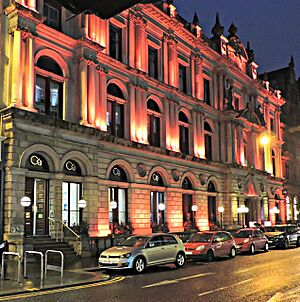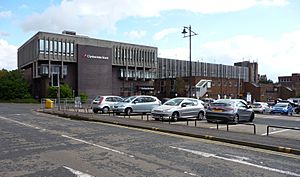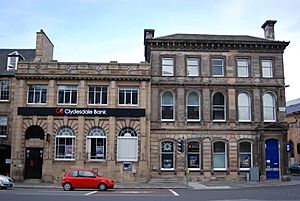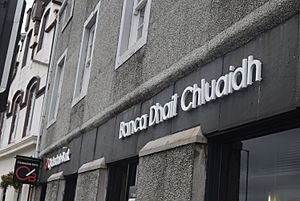Clydesdale Bank plc facts for kids

The historic headquarters of Clydesdale Bank in St Vincent Place, Glasgow
|
|
|
Formerly
|
Clydesdale Banking Company |
|---|---|
| Subsidiary | |
| Industry | Banking, financial services |
| Founded | 1838 |
| Founder | James Lumsden |
| Headquarters | Glasgow, Scotland, UK |
|
Key people
|
James Pettigrew (Chairman) Chris Rhodes (Chief Executive Officer) |
| Services | Retail banking SME banking |
|
Number of employees
|
c. 8,703 |
| Parent | Virgin Money UK |
| Divisions | Yorkshire Bank |
| Subsidiaries | B (online) |
Clydesdale Bank plc is a bank from Scotland. It was started in Glasgow, Scotland, in 1838. For many years, it was known as Clydesdale Bank. However, since 2019, it mostly operates under the name Virgin Money.
Over the years, Clydesdale Bank grew and worked with many businesses. It was bought by a very large bank called Midland Bank in 1920. Later, from 1987 to 2016, it became part of the National Australia Bank Group.
In 2016, Clydesdale Bank became independent again. Its new main company was called CYBG plc. In 2018, CYBG plc bought Virgin Money. After this, the Clydesdale and Yorkshire Bank names started to be replaced by the Virgin Money brand.
Today, all parts of the bank use the name 'Virgin Money'. Its main office is in Glasgow. It is one of the biggest banks in the UK. In October 2024, Nationwide Building Society bought Clydesdale Bank plc.
Like some other Scottish banks, Clydesdale Bank can print its own banknotes.
Contents
Bank's Beginning: 1838
How Clydesdale Bank Started
In March 1838, an advertisement appeared in Glasgow for a new banking company. It was called the Clydesdale Banking Company. The idea was for it to be a local bank with few branches. However, it would have connections everywhere. It was also decided that a branch in Edinburgh would be needed.
The bank officially opened for business in both Glasgow and Edinburgh in May 1838. It was created by a group of Glasgow business people. These people were active in the city's government and charities.
The main person behind starting the bank was James Lumsden. He was a stationer, a city councillor, and later became the Lord Provost of Glasgow. Another founding member, Henry Brock, became the bank's first manager. He was an accountant and helped start the Glasgow Savings Bank.
Even though the advertisement said it would have few branches, the bank quickly grew. In its first year, it opened three branches in Glasgow. It also opened its first country branches in Campbeltown and Falkirk. By 1844, seven more branches had opened. The bank also bought the Greenock Union Bank, which had four branches.
Growing the Bank's Network
After buying Greenock Union, the bank didn't change much for a while. In 1857, it still had only 13 branches. That year, Clydesdale Bank was the first Scottish bank to show its financial information publicly. This showed it was strong.
This was good timing because soon after, two other Scottish banks, the Western Bank of Scotland and the City of Glasgow Bank, closed down. Clydesdale Bank gained many new customers and 13 branches from the Western Bank.
A few months later, Clydesdale Bank took over the Edinburgh and Glasgow Bank. This bank had become weak due to economic problems. The Edinburgh & Leith Bank, as it was first called, started in 1838 to help "industrious middle classes." It had bought other banks before becoming the Edinburgh & Glasgow Bank. However, it had made some bad loans, especially to Australia. Clydesdale Bank took it over for free and kept 19 of its 27 offices.
Five years later, in 1863, Clydesdale bought the Eastern Bank of Scotland. This bank also started in 1838 and was based in Dundee. This purchase gave Clydesdale its first branches north of the River Tay.
Expanding Across the UK
Most of the bank's growth came from buying other banks. The management was careful about opening new branches themselves. However, in 1865, a group was formed to look for new places. They opened 16 branches in just two years.
In 1874, Clydesdale Bank opened three branches in Cumberland, England. This was to help existing customers who traded there, not to enter the English market fully. Clydesdale was one of the last Scottish banks to open an office in London, which it did in 1877.
In 1878, the City of Glasgow Bank failed again. This led to more people putting their money in Clydesdale Bank. Clydesdale also gained nine of the Glasgow branches from the failed bank. After this, a new law was passed in 1879. This law allowed banks to limit how much money their owners could lose if the bank failed. Clydesdale Bank officially became a limited company in 1882.
The years between 1890 and 1914 were quiet for the bank. However, its branch network steadily grew from 92 to 153. This period marked the end of Clydesdale Bank being fully independent.
Changes in Ownership
Midland Bank Takes Over
In 1917, London City and Midland Bank (later called Midland Bank) wanted to buy Clydesdale Bank. Even though Clydesdale first said no, it was sold in 1920. However, it continued to run on its own and was seen as a partner, not just a part of Midland Bank.
Banks in Glasgow faced tough times between the two World Wars. Clydesdale Bank went from being the largest lender in Scotland in 1920 to fifth place by 1939. Despite this, the bank kept opening branches, especially in areas where exports were growing. The number of branches increased from 158 in 1919 to 205 in 1939.
Midland Bank had also bought the North of Scotland Bank in 1923. But the managers in Aberdeen strongly resisted joining with Clydesdale. After the Second World War, the two banks could not stay separate. In 1950, they joined together to become the Clydesdale and North of Scotland Bank. This name was soon shortened to Clydesdale Bank.
Clydesdale had 189 branches and the North of Scotland had 161. Together, they covered 221 towns. Before the merger, Clydesdale was the third-largest Scottish bank, and North of Scotland was the smallest. The new combined bank became Scotland's largest in terms of money held and branches. However, by 1969, other bank mergers meant there were only three Scottish banks left, and Clydesdale was the smallest. Midland Bank decided to sell Clydesdale (along with its Irish banks) to National Australia Bank in 1987.
Part of National Australia Bank

In 1989, National Australia Bank bought Clydesdale Bank for £420 million. During this time, a person named Fred Goodwin worked on the deal. He later became a high-ranking manager at Clydesdale Bank.
In September 2013, the bank was fined £8.9 million. This was because it had calculated mortgage payments incorrectly for over 42,000 customers.
In March 2015, a government committee said that Clydesdale Bank had wrongly sold certain business loans. They also said the bank's own review of these sales was not good enough.
In April 2015, Clydesdale was fined £20.7 million. This was the largest fine of its kind given by the Financial Conduct Authority at that time. It was for wrongly selling PPI insurance.
Becoming CYBG plc
In October 2014, National Australia Bank said it planned to leave the UK. It was looking at different ways to sell Yorkshire and Clydesdale Banks, possibly by selling shares on the stock market. In October 2015, National Australia Bank confirmed it would sell shares of Clydesdale Bank and Yorkshire Bank on the London Stock Exchange (LSE) in February 2016. They hoped to raise £2 billion.
The new company that owned the banks, CYBG plc, started trading shares on the LSE and the Australian Securities Exchange on February 3, 2016. The starting share price meant that National Australia Bank lost about £2 billion on the sale. They also had to set aside about £1.7 billion to cover claims for wrongly sold products.
In March 2016, CYBG announced it would close 28 branches to save money. The next month, they announced more closures: 9 Clydesdale branches and 17 Yorkshire Bank branches.
The Virgin Money Era
In June 2018, CYBG plc announced it would buy Virgin Money for £1.7 billion. This deal meant that many employees might lose their jobs. Also, customers would slowly move to the Virgin Money brand over three years. The purchase of Virgin Money was completed on October 15, 2018.
In June 2019, CYBG plc said it would bring all its businesses under the Virgin Money brand. Clydesdale Bank, Yorkshire Bank, and B (an online bank) started using the Virgin Money name in late 2019. The full change was planned for early 2021. To get ready for this, the original Virgin Money plc joined with Clydesdale Bank plc on October 21, 2019.
Acquisition by Nationwide Building Society
Clydesdale Bank plc was bought by Nationwide Building Society on October 1, 2024. The Virgin Money brand is expected to be gradually replaced by the Nationwide brand by 2030.
See also
- List of banks in the United Kingdom



